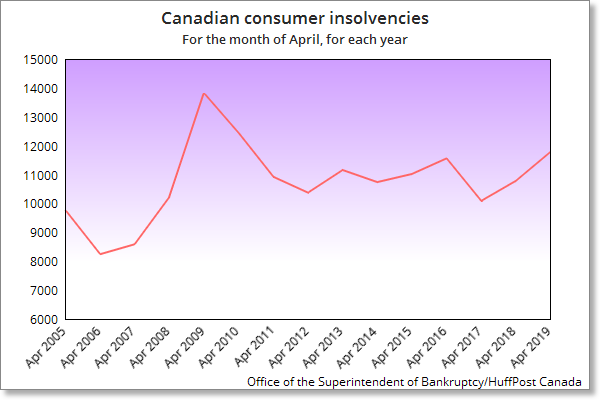
The Bank of Canada may be pulling back on hiking interest rates, but Canadians are still dealing with the fallout from the rate hikes we’ve already seen.
Consumer insolvencies in Canada jumped by 9.3 per cent in April, compared to the same month a year earlier, according to data from the federal Office of the Superintendent of Bankruptcy. The number includes both consumer proposals and bankruptcies. Consumer proposals are an increasingly popular alternative to bankruptcy, where the debtor works out a deal with creditors to pay a portion of their debt.
The 11,785 insolvencies recorded in April are the highest for the month since 2010, when Canadian consumers were still recovering from the Great Recession.

Insolvencies rose most in Newfoundland (up 51 per cent) and Alberta (up 18.7 per cent) but also saw significant increases in Ontario (up 11.2 per cent), British Columbia (up 5.8 per cent) and Quebec (up 5.3 per cent). Saskatchewan (down 11.7 per cent) is the only province to have seen a decline.
The data suggests many households are unable to adjust to higher debt payments, especially given that consumer debt once again hit record-high levels in the final months of 2018.
And many debtors are beginning to realize the extent of the problem. In a survey carried out for FP Canada and Credit Canada this spring, one in five Canadians said they would have to liquidate assets this year to pay off debt — meaning cashing in RRSPs, selling a car or otherwise raising cash to cover debts.
Watch: Canadians are dipping into their RRSPs to survive. Story continues below.
And while mortgages have been responsible for a great deal of the run-up in household debt, it may be more frivolous forms of borrowing that are driving households to insolvency.
“What I’ve been hearing from Canadians is (they are) overspending,” said Kelley Keehn, a personal finance educator and consumer advocate with FP Canada. “Some of it is just not paying attention (to your finances).”
One common mistake, she says, is making only the minimum payment on your credit card. Many people with high credit card balances will need decades to pay off what they owe ― decades of paying very high interest rates.
“That high rate is working for the credit card company and grossly working against you,” she says.
Keehn says keeping an emergency savings account ― and keeping it funded ― is crucial. Additionally, many people fear their financial statements, or are bored by them.
“You’ve got to open up your bills, know what your credit card rates are,” she says. And while a spending budget may be unrealistic for many people, she suggests “a 30-day anti-budget”: Simply keep track of everything you spend money on for 30 days. Check your credit card and debt card balances, and keep receipts for cash purchases.
“Your spending can be a huge eye-opener” when you add it up over a month, Keehn says. “You will find there is always some fat to trim.”
Forget about keeping up with the neighbours
For those facing money trouble, a financial planner or counsellor can make a big difference, Keehn says, and their services can be bought by the hour. There are also non-profit credit clinics that can help those in need.
Finally, don’t let yourself get caught up in trying to keep up with others’ lifestyles, Keehn says. You may not realize the Joneses you’re trying to keep up with are in financial trouble themselves.
“You have no idea who you’re comparing yourself to, trying to keep up with that lifestyle,” Keehn said. “That person is probably going into debt.”